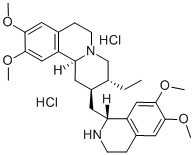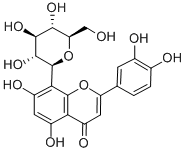Emetinedihydrochloride , ≥98% , 316-42-7
Synonym(s):
6ʹ,7ʹ,10,11-Tetramethoxyemetan, 2HCl;6′,7′,10,11-Tetramethoxyemetan dihydrochloride;Emetine, Dihydrochloride - CAS 316-42-7 - Calbiochem
CAS NO.:316-42-7
Empirical Formula: C29H42Cl2N2O4
Molecular Weight: 553.56
MDL number: MFCD00135589
EINECS: 206-259-8
PRODUCT Properties
| Melting point: | 240-250 °C (dec., dry matter)(lit.) |
| alpha | D +11° (c = 1) to D +21° (c = 8) |
| storage temp. | 2-8°C |
| solubility | DMSO:55.36(Max Conc. mg/mL);100.0(Max Conc. mM) |
| form | White solid with a faint yellow cast |
| color | white to off-white white |
| Water Solubility | Soluble to 100 mM in water |
| Merck | 14,3559 |
| Stability: | Stable. Combustible. Incompatible with strong oxidizing agents. Light and heat sensitive. |
| EPA Substance Registry System | Emetine, dihydrochloride (316-42-7) |
Description and Uses
Emetine, an alkaloid from ipecac, C29H40O4N2, is a white powder with a very bitter taste. The substance is soluble in alcohol and ether, slightly soluble in water. Emetine darkens upon exposure to light. The compound is derived by extraction from the root of Cephalis ipecacuanha (ipecac). It is also made synthetically. Medically, ipecac is useful as an emetic (induces vomiting) for emergency use in the treatment of drug overdosage and in certain cases of poisoning. Ipecac should not be administered to persons in an unconscious state. It should be noted that emesis is not the proper treatment in all cases of potential poisoning. It should not be induced when such substances as petroleum distillates, strong alkali, acids, or strychnine are ingested.
Safety
| Symbol(GHS) |  GHS06 |
| Signal word | Danger |
| Hazard statements | H300-H315-H319 |
| Precautionary statements | P264-P270-P280-P301+P310-P302+P352-P305+P351+P338 |
| Hazard Codes | T+ |
| Risk Statements | 28-36/37/38 |
| Safety Statements | 26-28-36/37-45 |
| RIDADR | UN 1544 6.1/PG 1 |
| WGK Germany | 3 |
| RTECS | JY5250000 |
| F | 3-8-10 |
| HazardClass | 6.1(a) |
| PackingGroup | I |
| Toxicity | LD50 (calculated as base) in mice (mg/kg): 32 s.c.; 30 orally (Child) |




